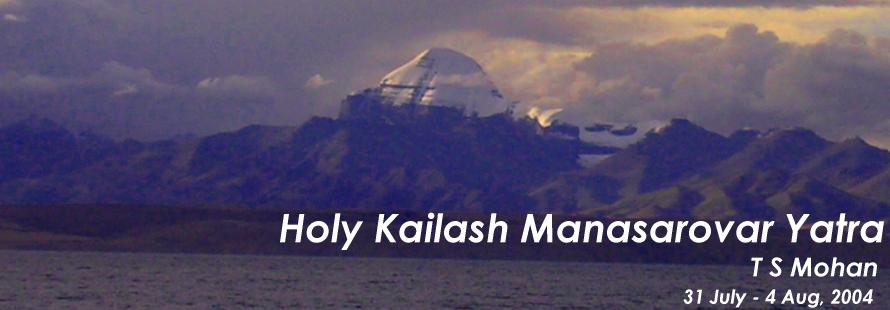|
| Starting the Parikrama in 'Tar Po Che' - the Valley of the Gods | |
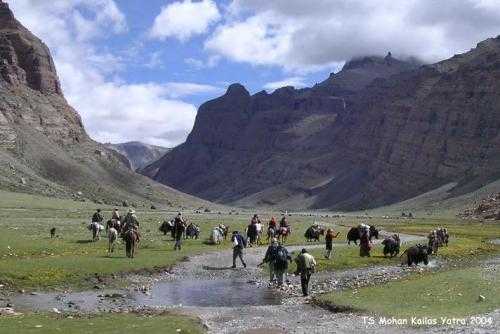
|
|
The Yatris start off on the Parikrama trail along 'Tar Po Che'. In the photo, the Yaks are getting loaded with the camping equipment.
Some have started off on the horseback.
|
| Along the River 'Lha Chu' | |
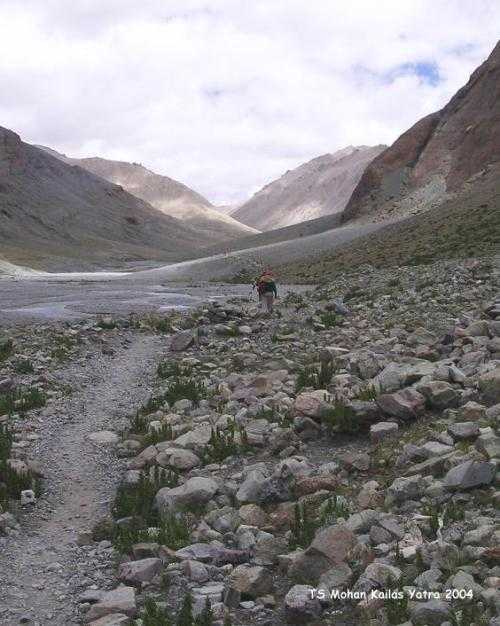
|
|
This is all that is there to guide a Yatri - the trail. Most trek alone - lost in the sublime!
|
| Gracious Valley | |
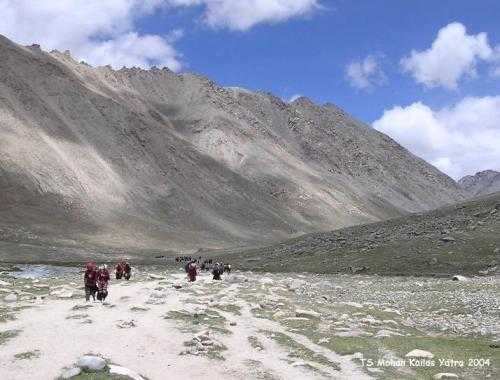
|
|
Sometimes the trail is clear and flat. A lot of Bon-Pa devotees
cross you, doing the 'kora' trekking in the opposite direction. We greet them with a call - 'Tashi Delek'.
|
| Water Fall along the valley. | |
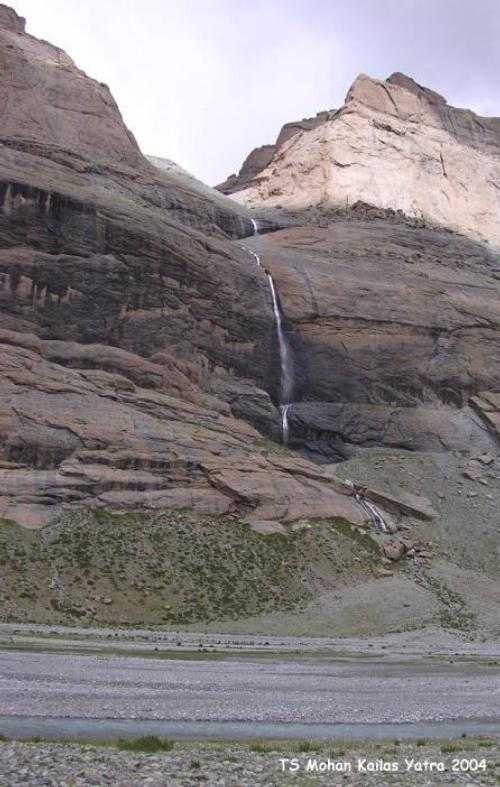
|
|
Several such waterfalls off the rugged and steep valley mountains greet the Yatris. This
one was across the river and facing Mt. Kailash.
|
| The BonPa Pranam | |
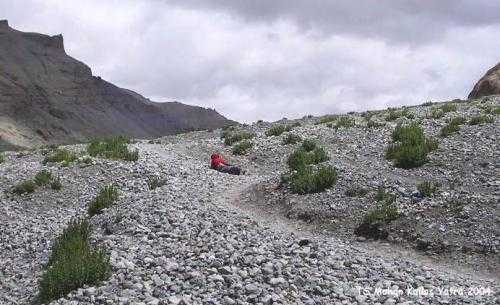
|
|
Do you have the devotion, inspiration, grit and perseverance to do a parikrama with shastanga namaskars only? Along
the way you will come across boulders, rocks, rivulets, snow, etc. Some Bon-Pa devotees do! Here is one.
|
| Mt.Kailas - First view along the parikrama | |
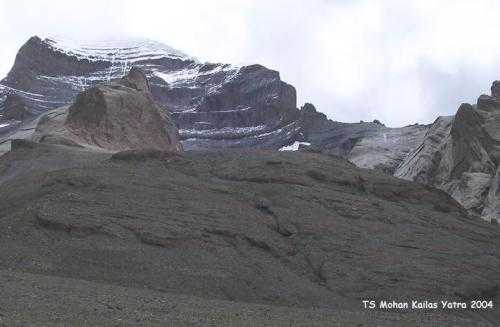
|
|
This is the first view that we get of the Holy Mountain. So near and yet so far. There is a hidden
valley between us and the mountain.
|
| The Classic view of Mt.Kailas | |
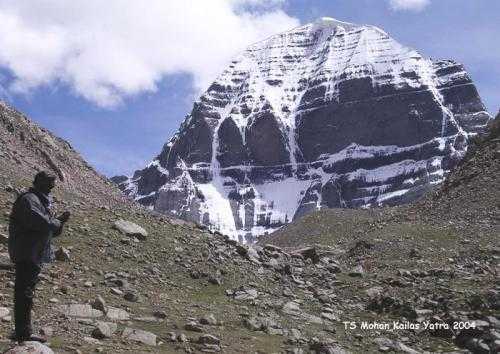
|
|
Beautiful as it is when seen in person, this classic view is the best and the only full one that
we get during the entire parikrama.
|
| Mt.Kailas - a close up. | |
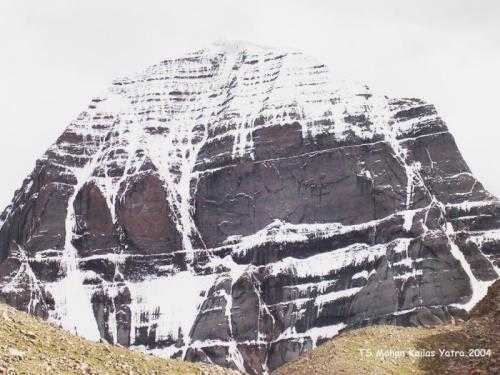
|
|
The sheer vertical walls of this holy mountain are several hundered meters in height. From this location,
the mountain is about 3 kms away and about 2 kms into the sky.
|
| Dheer Puk Gompa near Mt.Kailas | |
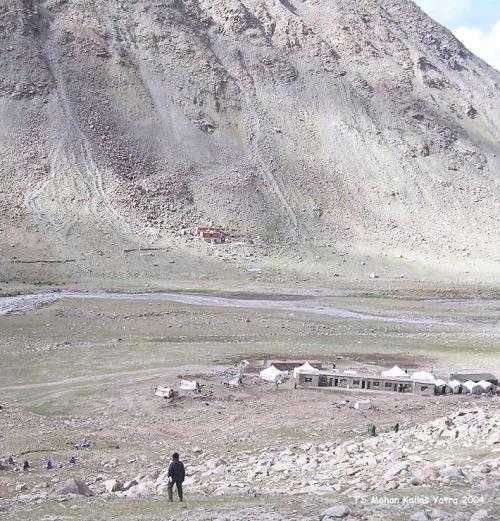
|
|
This Gompa is located across the river. Can you see the small brown colored building? It is a huge structure.
And the mountain behind is even more huge!
|
|
|
The Yatra Diary
Day 7: Sunday, 1st August 2004
From Darchen to Tar Po Che to Dheerpuk
The day one of the Parikrama had arrived. We packed light for the three day trek. Most of our personal
luggage was left behind in the truck. The minimal requirements were packed and brought by the Yak.
After breakfast we were taken in the vehicle to the general
Buddhist kora starting point - 'Tar Po Che' - or the Valley of the Gods - about 6 kms away from the village of Darchen.
It had a tall flagpost
with a lot of Buddhist prayer flags - with the main prayer 'Om Mani Padme Hum' - tied around it in several directions.
With a namaskar to Lord Shiva, Ganesha and Guru, we started the parikrama. Each one on his own! Perhaps
within calling distance of each other - within an hour some had gone beyond and some had started to
lag far behind. The river 'Lha Chu' flows nearby and we go
along its banks, in the valley between two close mountain ranges. Wonderful scenes! Sublime and spiritual!
 




|
Chanting Mantra along the Parikrama
The beauty and peace of the valley and the mountains including Mt. Kailash makes a devout yatri's mind swim in the
spiritual sublime. There is the spontaneous chant of several mantras according to one's ' Ishta bhava'!
To start
with there is the all powerful 'pranava' mantra - the chanting of 'OM' synchronized with 'pranayama' - the
yogic method of deep breathing. At that time we can meditate on the Oneness of the inner with the outer.
And then we have the 'Shiva Panchakshari Mantra' - 'Om Namah Shivayah' that reverberates
internally. And then there is the 'Hara hara Shankara, Jaya Jaya Shankara, Shiva Shiva Shankara' to
resonate with one's trekking beat. Add to it your own Ishta devata mantra. And then there is the
'Mrthyunjaya Mantra'. So are several other mantras - each private to the person having it.
The Buddhists chant the mantra of peace - 'Om Mani Padme Hum'.
All these chants happen within the mind even as it soaks in the glory of 'Tar Po Che!'.
The big question - why do we pray? Popular notions amongst the general religious folks
is that undertaking such a yatra will destroy the 'sins of a lifetime' or will help one get over one's
current problems even as one (unwittingly) persists in one's problem causing behaviour - well - God bless such
folks.While good and bad karma creation and experience happen concurrently, I think it is futile to do these yatras
without the right approach and motivation. Especially a spiritual approach and motivation!
We pray so that we can weaken and get over our own 'vasanas' - traits that create bad karma. We pray
so that our people can get over their bad karma creating habits. We pray so we can do good karma. We pray
so that our own people can do good karma - and thus they can get over from the vicious cycle of problems that they
create for themselves and us. We pray so they can have the peace of mind.
Why peace of mind? It is so easy for
one to blame others for self-created problems even as one persists in these futile behaviours - these are
pretty commonly seen in inter-personal relationships. And the peace of mind will help in the clarity of introspective
thought - which in turn will help one amend her or his behaviour.
Ofcourse of profound significance is the 'mahavakya' from sages
down South India - 'Anbe Shivam!' - the true meaning of love is Shiva! In it lies the secret of understandingly
putting up with the above troubles.
'O Lord, May we have the 'vairagya' - detachment to see the reality clearly, the 'titiksha' - fortitude to bear
the ill-will generated by our own folks in their delusions, and the 'karuna' - compassion to pray for everyone's well being!'.
Yes, by prayer, we seek God's grace! We seek to have the courage to see our follies, so we can change them with
our 'free will' and sadhana efforts! We seek to have the wisdom to see the play of God's grace where we have no
control or influence though others might imagine we or they have! Like the other's emotional behaviours!
And self-inflicting
painful actions (The conceited will deny any suffering! 'I was shrewd to get away from it!', would be the
bravado claim!)
This, in a nutshell, is the '2-cents' worth (non-fatalistic) karma and prayer theory that I believe in!
|
I crossed several devotees from various other groups - I wished each one of them a warm 'Om Namah Shivayah' - some were
from Chennai, some from Mumbai, some from Chinmaya Mission, some from Gujarat, some from
Delhi... and many were Tibetans! Coming in the
opposite direction were the BonPa devotees (Tibetans) who counter-circumbulate the Holy Kailash.
In fact some did it with sastanga namaskars all the 50+ kms - through the rocks, boulders, streams
and up-gradients! Wonderful energy, stamina and what a spiritual faith these people had! I do
a namaskar to everyone that I come across - old and young, steady and inspiring. With every such
Tibetan, it is loud call of 'Tashi Delek' which brought a smile on their face and reciprocated greetings!
In between, the mind is immersed in Lord Shiva and His beautiful creations around, resounding to
the continuous inner chant of 'Om Namah Shivayah!' as well as other mantras.
| Lord Shiva
 'Shravana masa' is an auspicious month for the devotees of Lord Shiva and is spent in devotions,
austerities, and meditations. Lord Shiva is symbolized to be catering to the devotees from their lowest
level of spiritual evolution to the highest. From 'Kala Bhairava' - the grossest keeper of time (death or endpoint
of any activity) to the Lord Dakshinamurthy - profoundly absorbed in teaching the Non-Dual reality in silence!
'Shravana masa' is an auspicious month for the devotees of Lord Shiva and is spent in devotions,
austerities, and meditations. Lord Shiva is symbolized to be catering to the devotees from their lowest
level of spiritual evolution to the highest. From 'Kala Bhairava' - the grossest keeper of time (death or endpoint
of any activity) to the Lord Dakshinamurthy - profoundly absorbed in teaching the Non-Dual reality in silence!
Lord Shiva is best comprehended as that Non-Dual Reality that is everywhere and indivisible - with no
attributable qualities and yet the Being that one experiences in the inmost depths of oneself! And as Sri
Dakshinamurthy, the youthful and blissful Shiva communicates through silence to the elderly and wise disciples.
The Lingashtakam poetically describes the Shiva Linga as that non-dual reality comprising this Universe - the 'Brahma�da!'
The Yajur veda devotionally describes Him to be the Master Yogi. The Shiva Mahima Stotra captures Him as a Hero
removing the undesirable from this world - the Neelakanta! And then there are so many Shiva Mantras and the texts
of Saiva Sidhaanta - 'Periya Puranam', 'Thirumandiram' - are replete with descriptive expressions of sages who have experienced so many forms of Him!
|
After several hours of trekking (and with
several mild breathless hikes up the smoothly increasing gradients) we reached Dheerapuk (4800m) - a loftly place
from where Mount Kailash blesses you with a wonderful view of the north- north-western face. Because all along the various
mountain ranges surrounding Mount Kailash obscured the view. In fact, this is the only place within
the parikrama trail that we are closest and we can most visibly see the holy Mountain. Beyond this, for the
next two days of trek we were not be able to get a glimpse again.
The camp was set up beyond
the Dheerapuk monastery and near the primitive bridge over the river. Beautiful place. Dark
clouds hovered, it started raining. Opening and closing the zip of the
tent was strenous - am panted for breath. Interesting. Within a tent we had a group chant and prayer. Later, too tired, after separate
dinner within tents, I just went to sleep. Om Namah Shivayah!
 







|
Parikrama Programme at Mt. Kailas and Manasarovar
When you go in a group - you are lost in the group activities. And when you go alone - you might be lost
in not knowing what to do. Also remember that there are no formal temples around.
So here is a checklist for the latter types.
v At Kathmandu, start the
parikrama with a visit to the Pashupathinath Temple by foot from your hotel. At the temple, choose to
spend a few minutes on the river ghat meditating at the flow of time, water and life, in that holy place.
v Do not forget to purchase
the Prayer Flag for offering to Devi Tara at the Drolma Pass during the Kailash Parikrama.
v Enroute, at the first sightings of the Holy Lake
and the Holy Mountain, the driver typically circumbulates the Buddhist Prayer Flag mast and prostrates fully to
'Kang Rinpoche'. Join him. Pray and meditate on Lord Shiva - as the distant Kailasa parvata along with the 'Ashta parvats'!
v Ask that at every Gompa that you will
come by, the vehicle shall stop to allow you to offer pranams. There pray and meditate on Lord Shiva and your Ishta devata also.
v Go over to drive along the Rakshas Tal shore.
King Ravana of the Ramayana
fame is said to have meditated on Lord Shiva here.
v Ask to camp at Chiu Gompa. Dont miss the hot springs (though it is difficult to come by on a rushed tour). If you are here on the Purnima day, do not miss the night
calm - it is a wonderful time for prayer and meditation. Sleep late. Get up early.
v Meditations along the banks of
the Lake Manasarovar can be done before the religious bath in the cold waters. At noon when it is relatively warm, take the dip facing Mt. Kailas
and do not forget to offer 'argyam' to the Ishta and the Gods, and prayers for forefathers. Do offer prayers for your people.
And those that would like offer 'tarpanams' to their departed dears do it here.
v Do closely watch the flora and fauna that populate
the seemingly desolate but rich landscape - off the lake on the one side and the mountains on the other.
v Reach Darchen early in the afternoon. Then
plan to go to 'Ashtapad'- it is a climb for about 7 kms. You can see the southern face of Mt.Kailas as well as the
surrounding inner valley from here.
v Start the parikrama early from Darchen itself if possible.
With a manasika pooja to Lord Ganesha and Shiva, trek to 'Tar Po Che'. Then to Dheer puk. Carry atleast 3 liters of water.
Several spots along the way afford for wonderful 20 minute meditations. Do not miss when you feel you wish to do.
v Reach Dheerpuk early. The North - north western
face of Mt. Kailasa is wonderful. Climb over cusp between the mountains - there is a prayer flag stupa. Go beyond and you
will start approaching the base of the mount kailash over a glacier and a rivulet that flows down into 'Lha Chu'.
Go as nearer as possible. Pray and Meditate. Ask for a campsite near the Inn there. Look overnight at the Mt. Kailas
in the beautiful moon light. Yes, weather can play spoilsport. It is too beautiful to miss out. Do a 'Shivaratri' there.
v When you start for Drolma La, cross the bridge
and visit the
Dheerpuk Gompa if possible - it is a retro trek on the otherside of the river bank. The view from here is also wonderful.
Pack atleast 4 liters of water for the climb. You will need all of them.
v At the Droma La Pass, offer
your prayer flag to Devi Tara.Though
crowded perhaps, choose a nice place to sit and meditate for sometime. It is wonderful to see a lot of
beautiful color and peace amongst the rugged peaks and boulders. Is life like that?
v If possible and if you are not
very tired of climbing up again, go down to the Gauri Kund - depending on the season you might find
several small ponds along. The water is absolutely magical and holy! Lord Ganesh was born here says
the legends! Choose a place, pray and meditate!
v
During the Summer, and
specifically during Shravan, you will rarely come across snow. Yet, after getting past Gauri Kund, you
will descend to a disappearing glacier and will have to cross it. Stop after getting into the middle of the
pathway, take a panoramic view and allow the mind to ascend to the eternity .. hold it that way for a
few minutes.
v After coming down to
the banks of the river Lham Chu, choose a nice spot amidst the rocks in between the flowing waters. And
you said it - pray and meditate on Lord Shiva. The trek thereon is almost on level ground - perfect
for a step synchronized chant in the mind even as the vast ambience around sinks deep in.
v
At Zutul Puk, do visit the Gompa and pray inside the cave where the Buddhist Monk Milarepa
stayed and meditated. Light yak ghee lamps and meditate on all the saints and sages that have
been enlightened by the presence of Mt. Kailash.
v At the end point, do
not fail to give thanks to all the Gods for having helped make your parikrama a successful one
thus far. Join the prayer flags in the hot sun perhaps to meditate on the meaning of a Parikrama
-- the inner journey and the outer circumbulation.
v Ask to camp at Hor Chu
(the place where the river Hor Chu meets Lake Manasarovar). And use the best of the opportunities
to meditate on the distant Mt. Kailash along
with its 'ashta-parvat' range.
v
Finally, on your way out, just before the Mt.Kailash and Lake Manasarovar finally disappears, ask for a stop at the
starting point of Manasarovar Parikrama.That is the exit route as well. You would have now completed the
Manasarovar parikrama
as well. Meditate on the significance of the entire yatra here. And offer your heartfelt gratitude to
Lord Ganesha and Lord Shiva here. Join the Buddhist flags in spreading your prayers calmly into the air.
|
|
|
